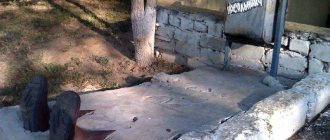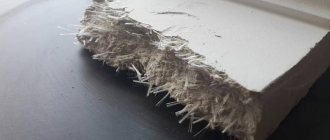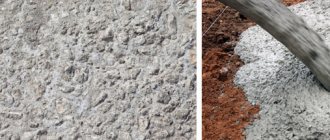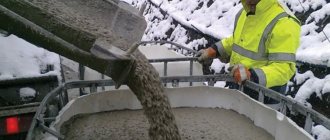Frost-resistant additives in concrete are special compounds that, in one way or another, can make concrete suitable for work at sub-zero temperatures without losing its basic technical characteristics. Modern manufacturers offer a variety of antifreeze additives that perform certain functions and in one way or another solve the problem of the inability to pour ordinary concrete at temperatures below +5 degrees.
Concrete is a universal building material that is used today in a variety of fields. Pouring various structures and completing elements, constructing buildings and other objects - all this work is carried out year-round, so the ability to use the solution at sub-zero temperatures is very important.
An ordinary solution at temperatures below +5 degrees ceases to set and harden, and even if the reaction takes place, it causes damage to the internal crystalline bonds and a significant deterioration in the properties of the material. Thus, concrete poured in the cold can become covered with cracks, chips, change shape, crumble and deform.
The optimal conditions for proper setting and hardening of the concrete solution are temperatures around +20 degrees and high humidity. If there is a need to work with concrete mixture in cold weather, it is important to use special additives. Features of the use of the compositions are indicated in the instructions, the work is carried out according to the rules specified in GOSTs and SNiPs.
How does concrete harden?
The main component of concrete is cement, which is a water-hardening binder. This means that in order to turn the powder component into a hard, rock-like material, it is necessary to mix the cement with water, which will initiate hydration reactions in the mixture.
In addition to cement and water, fine and coarse aggregates (sand and gravel or crushed stone, respectively) are added to concrete mixtures.
From the school chemistry course we know that in each type of chemical reaction substances react with each other in certain proportions. Let's say that in order for hydration reactions to take place in a concrete mixture, the ratio of water to cement, otherwise called the water-cement ratio, must be 0.3.
Excess water, added to the mixture for the sake of a more plastic and easy-to-work consistency, ultimately is not involved in hydration reactions and evaporates over time, leaving cavities in the concrete structure that reduce its strength.
Reference
The problem of concrete mixture hardness is successfully solved today by adding plasticizers, which make it possible to obtain mobile concrete mixtures without increasing the amount of mixing water (and therefore without reducing the strength of the finished concrete).
We recommend studying: Plasticizers
Operating principle
The use of antifreeze additives allows you to pour mortars at temperatures down to -50ºС. They are liquid or powdery formulations added to the mixture. It is important to know that concrete additives added during frost provide only 30% hardening. Final hardening occurs after the monolith is defrosted.
There are several types of antifreeze additives, differing in their principle of action:
- Compositions that lower the freezing point of the liquid, as a result, the process of cement hydration continues, setting proceeds according to the standard mechanism;
- Sulfate-based additives accelerate the compaction of concrete, which releases excess heat, increasing the rate of cement hydration;
- Complex additives increase the solubility and activity of cement laitance, while compounds resulting from the reaction with water reduce its crystallization temperature.
Why low temperatures prevent concrete from gaining strength
During the hydration reactions that occur in the concrete mixture, strong crystalline compounds are formed. But for these reactions to occur fully, certain conditions are necessary:
- ambient temperature +18–22° C;
- almost one hundred percent air humidity.
It is especially important to comply with these conditions during the period of critical strength gain. It is indicated in the design documentation and amounts to 30–50% of the design strength of concrete. Usually this indicator is achieved on the 4th–6th day of concrete hardening. Further conditions may not be optimal.
When mixed, the concrete mixture contains a fairly large amount of water, which has not yet reacted with the cement, and this situation continues until the concrete reaches critical strength. If at this time the ambient temperature decreases, the rate of hydration reactions also decreases, and at temperatures below +5°C, hardening practically stops. At negative temperatures, the water in the mixture freezes and hydration reactions stop, therefore, the hardening of concrete stops.
What problems arise at low temperatures:
- hydration reactions slow down or stop altogether;
- freezing of the material leads to its expansion and an increase in internal pressure;
- Ice crystals form around the reinforcement, which weakens the adhesion of concrete to the reinforcement.
All this leads to low quality concrete products.
Important!
If concrete has not reached critical strength and is frozen, after thawing it will begin to harden again, but will ultimately be less strong. Concrete that has reached critical strength can already be subjected to freezing. After thawing it will gain strength.
Storage of the drug
Sometimes the industry produces such red liquids, but most often there is a greenish-yellow additive that has a shelf life of one year.
Five-liter liquid containers can be stored at low temperatures. The anti-freeze properties are completely preserved after freezing. All the working properties of antifreeze remain with it. The liquid can withstand more than one hundred freezing and thawing cycles.
The trade name of the drug is Kreps construction antifreeze. There are original markings Kreps KGB, Kreps reinforced and Kreps TsSh. Such solutions, when added to a cement-sand mixture, do not form efflorescence. The average market price of liquid is about 200 rubles per 5 liters.
Manufacturers recommend starting work by adding it to water before starting to knead the dry mixture. Gradually adding the dry mixture to the solution of antifreeze liquid and water, you should achieve the desired consistency.
Why is concrete cast at low temperatures?
If temperatures below +5°C are harmful to concrete, why is concrete work carried out in such conditions?
The answer is simple: sometimes there is simply no choice.
There are many regions in Russia where optimal temperature conditions for concreting appear for a very short time. In fact, it is late spring or early autumn. It would be strange to cancel construction work the rest of the year.
But this is not the only reason; Sometimes winter concreting is done deliberately for the following reasons:
- in winter prices for building materials may be lower;
- on soft soils, in some cases, concreting foundations is possible only in winter;
- It is easier for heavy equipment to drive through frozen access roads.
Sand in bags (mountain)
Availability: In stock
Unit: bag
- 1
- 2
- 3
- 4
- 5
Sand in bags (mountain)
PURPOSE
Mountain sand is used in the construction of buildings and roads. Mountain sand is also used for backfilling. Since mountain sand contains various impurities, and when preparing mortars in construction, mountain sand is an indispensable building material.
INFORMATION
Quantity required per 1m3: 35-37 bags
Go to product
- 1
- 2
- 3
- 4
- 5
How to concrete at low temperatures
However, even in winter you can get high-quality concrete products. For this purpose, special methods have been developed and successfully used.
Important!
Concreting at average daily temperatures below +5°C or at minimum daily temperatures below 0°C is called, according to SP 70.13330, winter concreting.
For concreting at low temperatures, high-quality quick-hardening cements and Portland cements are used.
The concreting technology at low temperatures provides for the following measures:
- preventing freezing of the concrete mixture during its transportation, laying, and compaction;
- preventing the mixture from freezing until it reaches critical strength.
In fact, the following measures apply:
- introduction of certain additives into the concrete mixture;
- installation of shelters (warmhouses);
- heat retention in the concrete mixture;
- heating of freshly laid concrete.
How to prepare concrete mixture for work at low temperatures
The concrete mixture intended for laying must have a temperature of at least +5° C. In winter, the mixture cools down during transportation, so it can be prepared warm in advance, calculating the time so that it maintains the desired temperature by the time it arrives at the construction site.
Important!
The time for transporting the concrete mixture should not exceed 4 hours.
To prepare the mixture or solution, use warm and even hot (up to 70 ° C) water; The fillers are also heated. Cement should not be heated as it may boil. Then knead the mixture.
Important!
The formwork and reinforcement are also heated using warm air.
If the solution is to be transported for a long time, antifreeze additives are used.
Thermos method and dry hot thermos method
One of the methods of winter concreting is to retain heat in the concrete mixture.
The fact is that hydration reactions proceed with the release of heat; in other words, these are exothermic reactions.
Therefore, if you prepare concrete using warm water and heated aggregates, then lay it in heated formwork and cover it, the heat released during the hydration reactions may be enough to heat the concrete until it reaches critical strength. For covering, heat-insulating materials are usually used, such as polystyrene foam, boards, special mats, and PVC film.
The temperature inside the concrete is constantly measured to prevent a large temperature gradient between the temperature inside the structure and at its surface. A large temperature gradient can lead to an increase in pressure inside the structure, and it can “rupture”.
The thermos method is used independently or in combination with concrete hardening accelerators, thanks to which concrete gains strength faster.
We advise you to study: Concrete hardening accelerators
The advantages of the thermos method include:
- availability;
- simplicity;
- efficiency.
But there are also disadvantages: it is not suitable for small, thin-walled or large-area designs, and is also not effective at very low temperatures.
A special case of the thermos method is the dry hot thermos method, which allows you to lay concrete on a frozen base:
- Insulated formwork is installed.
- Expanded clay heated to a temperature of 200–300°C is poured onto the bottom of the formwork.
- Expanded clay is allowed to cool to a temperature of 100°C.
- Concrete mixed with warm water is laid and compacted.
As a result, the heat from the hydration reactions and from the cooling expanded clay is enough for the concrete to gain critical strength.
Teplyaki
Tents are called tents that are installed above laid concrete. Heat guns are installed inside the greenhouses in such a way as to maintain the temperature above +5°C.
This method is quite universal, but its disadvantage is that it is expensive: you need to have equipment, ensure the tightness of the tent, and waste electricity.
Methods for heating concrete
In cases where heat preservation methods are not suitable, various methods of heating the laid concrete are used:
- electrode;
- conductive;
- infrared;
- induction.
As the names suggest, heating with electrodes, infrared radiation, and an electromagnetic field is used.
All these methods are very effective, but require the use of expensive equipment and labor costs for its installation.
Important!
All methods of heating concrete and preserving heat (so-called warm concrete) are technically complex, requiring equipment and preliminary accurate calculations.
Application of antifreeze additives
In addition to “warm” concrete, there is “cold” concrete. This is concrete that is not heated, but uses antifreeze additives.
Antifreeze additives work in different directions:
- accelerate the course of hydration reactions, due to which concrete quickly gains critical strength;
- lower the freezing point of water.
Important!
Setting of concrete occurs in the first 2 hours after laying. The lower the water-cement ratio, the greater the proportion of water in the batch that is involved in hydration reactions. But with a low water-cement ratio, the mixture or solution turns out to be hard and inconvenient to work with. Therefore, antifreeze additives work simultaneously as accelerators and plasticizers.
Review of antifreeze additives
To accelerate the development of strength, various additives are introduced into concrete mixtures and cement mortars:
- chloride salts;
- nitrates;
- carbonates.
They increase the hardening rate in the first day by no less than 30%.
However, there are a number of limitations in their use:
- chloride salts are incompatible with metal fittings as they cause corrosion;
- high-alkaline Portland cements and cements obtained from clinker with a high content of aluminosilicates are incompatible with electrolyte salts;
- potassium and sodium salts are incompatible with aggregate of potentially reactive rocks;
- potash is not used at temperatures above 0°C, since it sharply accelerates the setting of concrete and makes it impossible to work with it; potash is also not used in concrete with conductors.
In addition, the use of salts can lead to the formation of efflorescence on the concrete surface.
That is why a profitable and convenient way to carry out construction and repair work using concrete mixtures and cement mortars at low temperatures is to use special modern antifreeze additives, for example, CemFrio and HotIce from CEMMIX, which combine the properties of antifreeze additives and a plasticizer, and therefore not only allow work in winter, but also increase the convenience of working with concrete mixture.
Let's look at the advantages of using modern antifreeze additives CemFrio and HotIce from CEMMIX:
- make it possible to carry out work at a temperature of –20° C without heating measures;
- do not have a negative effect on the reinforcement;
- additives are compatible with any types of Portland cement;
- combine anti-frost action with an accelerating and plasticizing effect, that is, in fact, three in one;
- savings on cement when using additives can reach 10%, which more than covers the cost of the additive;
- improve the workability of concrete;
- increase the strength of products by at least 10%;
- improve adhesion to reinforcement;
- safe for humans.
Thus, by using anti-frost additives CEMMIX, you get a flexible, workable concrete mixture that will quickly gain formwork strength even at very low temperatures.
It is important that ready-made supplements are convenient for dosing and easy to use.
Interesting!
The retail price of CemFrio in LeroyMerlin stores is 75 rubles per liter. With the recommended dosage of the additive, saving money on cement when producing 1000 cubic meters of B25 concrete will be about 130 thousand rubles.
Frost addiction
A frost-resistant chemical additive is added in cold conditions not only to concrete mortar, but also to other building mixtures. Construction antifreeze in liquid form can be added to dry mixtures already at minus 10 degrees. When adding liquid directly to the cement-sand mixture, the plasticity of the resulting solution increases significantly.
Each bottle of such liquid contains instructions indicating the percentage in accordance with the ambient temperature. The lower the thermometer, the more special liquid is required. Water is added to the dry construction mixture. It is possible to mix mortar with only one antifreeze. Then the concrete sets much faster.
In the climate zone of the central zone of the country, during cold weather, a solution with an antifreeze composition is mixed in a ratio of 1:4. Take one part antifreeze to four parts water.
Is it possible to make an antifreeze additive with your own hands?
Home craftsmen use improvised means to add to the concrete mixture. Thus, it is often recommended to use detergents as plasticizers: dishwashing detergents, inexpensive shampoos. However, the composition of detergents may be different, and the surfactant in them may be in different concentrations. Thus, there is no exact data on how much and what kind of detergent to add for a guaranteed effect.
As an anti-frost additive, ordinary table salt (sodium chloride) or electrolyte salts are added, but they can harm the fittings, and it is also not known in what quantities to add them.
Adding improvised materials to cement mortars is a risky business, and the cost of a mistake can be very high. Therefore, it is safer to use a lab-tested supplement that is labeled with the exact dosage and does not have the disadvantages of homemade supplements.
Of the existing methods of conducting concrete work at low temperatures, the most convenient and inexpensive are methods using antifreeze additives. To date, a wealth of experience has been gained in the use of electrolyte salts, but it shows that such additives are not always appropriate. It is much safer to use modern additives, developed and tested in laboratories, that combine the properties of an antifreeze additive, a hardening accelerator and a plasticizer. They are affordable, reliable, predictable, easy to use and economical.
Similar products
Water repellent for concrete and mixtures SILRES BS POWDER D (powder)
Dry organosilicon water-soluble water-repellent water repellent SILRES BS POWDER D produced by Wacker Chemie AG (Germany) is used as a dry additive in concrete and dry cement-based mixtures.
Volumetric hydrophobization gives products and structures excellent water-repellent properties for a long time, without affecting their strength and vapor permeability. Does not affect the color of concrete, plaster and masonry mixtures.











